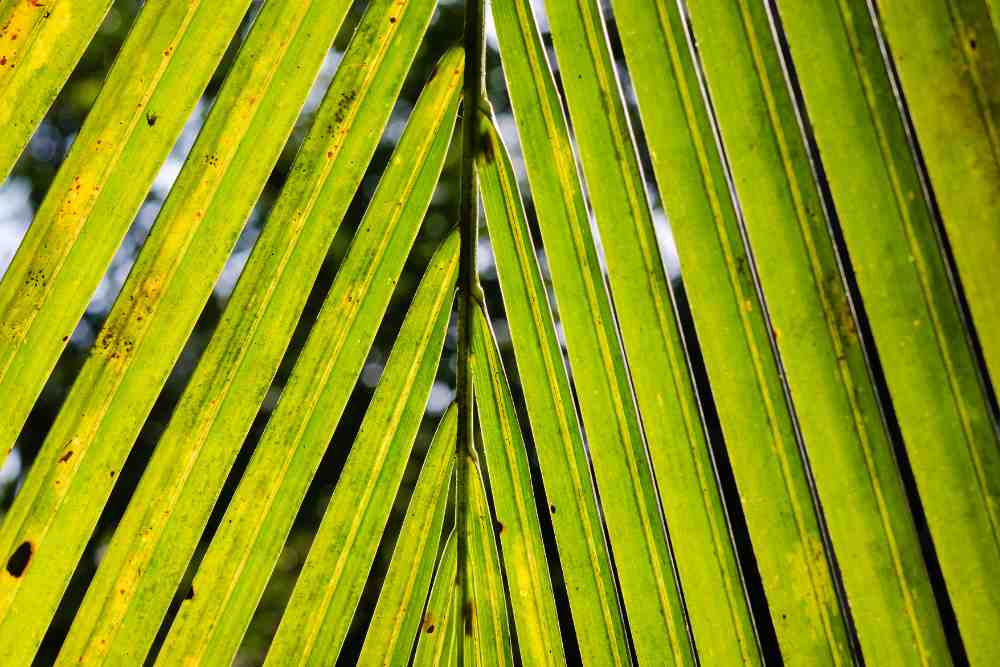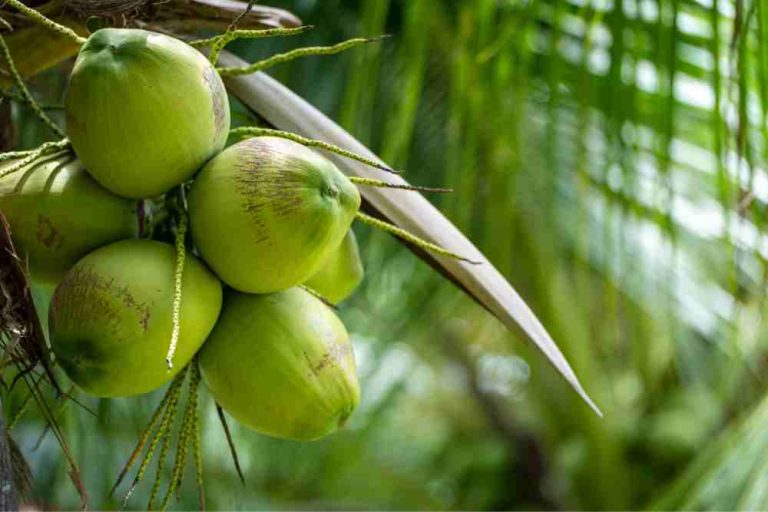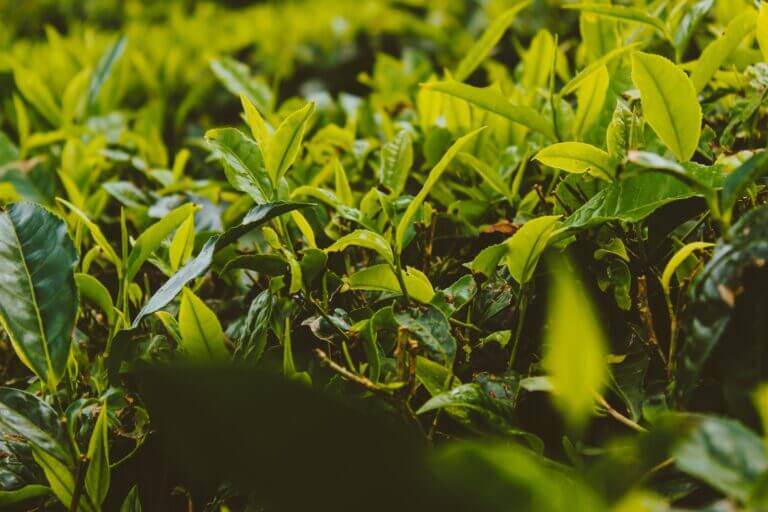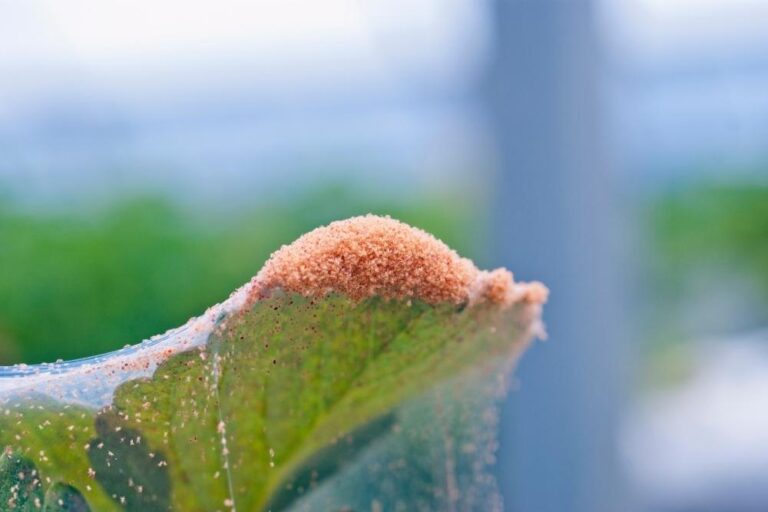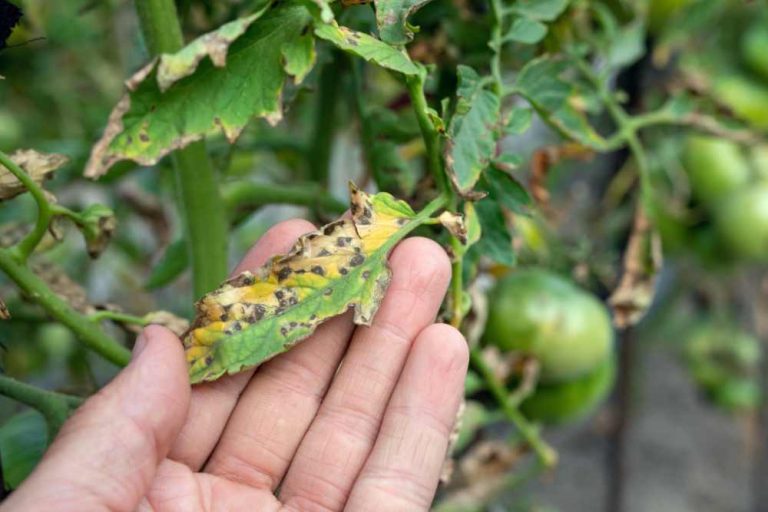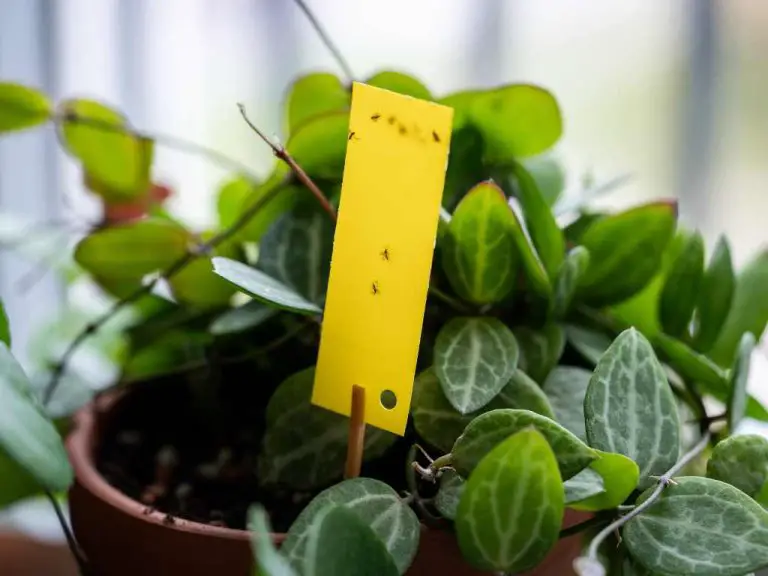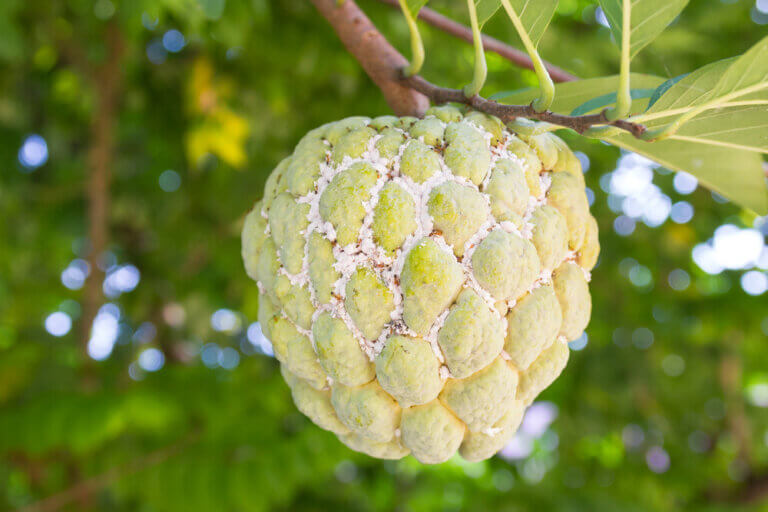6 Coconut Tree Diseases Treatment: A Comprehensive Guide
The coconut tree is not only lovely but also an extremely useful one. Coconut is cultivated in regions with intense tropical weather. It is commercially valued for beauty goods, oils, and raw fruit. However, various coconut tree issues might affect the proper development of this tree. Therefore, appropriate identification and treatment of any problems are essential for a coconut tree to thrive. Let’s get to know some coconut tree diseases treatments.
Shielding Coconut Trees from Pervasive Diseases
Coconut trees are not only aesthetically pleasing but also economically significant in many tropical regions. However, their susceptibility to various diseases can dramatically impact productivity and sustainability. Implementing effective preventative measures is crucial for safeguarding these valuable trees from harmful diseases. Here’s an insightful guide on how to proactively protect your coconut groves:
1. Cultivating Disease-Resistant Varieties
- Research and Select: Opt for coconut varieties known for their resistance to common diseases like lethal yellowing, bud rot, and root wilt.
- Diversification: Plant a mix of varieties to reduce the risk of widespread disease in a monoculture environment.
2. Regular Health Inspections
- Routine Checks: Conduct systematic inspections of the coconut trees to spot early signs of disease or pest infestations.
- Expert Consultation: Engage with agricultural extension officers or plant pathologists for professional advice on disease identification and management.
3. Nutrient Management
- Soil Testing: Regularly test soil to determine nutrient needs and adjust fertilization accordingly.
- Balanced Fertilization: Use a balanced fertilizer regime to avoid nutrient deficiencies or excesses that can weaken trees and make them more susceptible to diseases.
4. Proper Water Management
- Irrigation Systems: Implement efficient irrigation systems to avoid water stress and waterlogging, both of which can predispose trees to diseases.
- Drainage Improvement: Ensure good field drainage to prevent root rot and other waterborne diseases.
5. Good Agricultural Practices
- Pruning: Regularly prune to remove dead or diseased fronds, which can be breeding grounds for pathogens.
- Sanitation: Keep the plantation free of debris and fallen leaves that can harbor disease agents.
- Spacing: Plant trees at an appropriate distance to ensure adequate air circulation, reducing the humidity that fosters fungal growth.
6. Pest Control
- Integrated Pest Management (IPM): Employ IPM strategies to control pests that can act as disease vectors.
- Biological Control: Use natural predators or parasites to manage pest populations.
- Chemical Control: Apply pesticides judiciously, targeting specific pests while minimizing environmental impact.
7. Environmental and Climatic Considerations
- Microclimate Management: Modify plantation microclimates, if possible, to make conditions less favorable for disease development.
- Weather Monitoring: Keep track of weather patterns, as certain diseases are more prevalent under specific climatic conditions.
8. Use of Biological Agents
- Beneficial Microorganisms: Apply biological agents like Trichoderma or Pseudomonas species, which can act as biocontrol agents against certain pathogens.
9. Community-Level Coordination
- Local Collaboration: Work with nearby plantations to manage disease, as pests and pathogens can easily spread from one farm to another.
- Education and Training: Participate in local workshops and training programs to stay updated on the latest disease management strategies.
1. Stem Bleeding
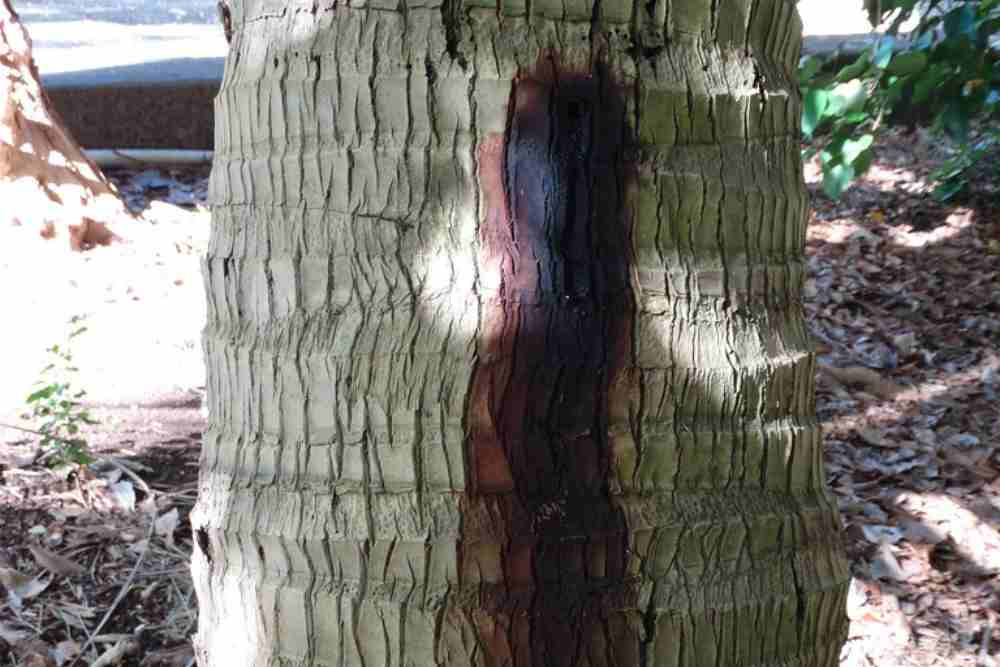
The distinguishing sign is the exudation of a reddish-brown fluid from the stem fractures. The exudates dry up, producing a black crust as the liquid trickles several feet down the stem. The tissues beneath the fractures develop yellow and perish.
The bleeding patch becomes higher as the disease worsens, and more of the area beneath the bark begins to rot. Reduced nut production and decreasing tree vigor are the results. The tree doesn’t die immediately; instead, it becomes unprofitable to maintain. In extreme circumstances, the trees can go dormant and die off.
The fungus makes two different types of conidia. Macroconidia can grow individually or in chains on conidiophores. They are round and have a dark green color. Endogenous microconidia are created within the long cells, which rupture once they reach maturity and release the microconidia in a long chain.
Microconidia (endoconidia) are cylindrical, hyaline, and have thin walls. Hyaline perithecia is another product of C. paradoxa. These perithecia have a long neck base decorated with knobby appendages, and the ostiole is coated in many pale-brown, erect, tapering hyphae. Ascospores are hyaline and ellipsoid, and asci are clavate.
A lot of irrigation or rainfall followed by a dry spell, shallow loamy soils or laterite soil with a rock or clay layer below the surface, improper garden upkeep, and Xyleborus and Diocalandra beetle damage are also factors.
The fungus lives in the soil and plant waste as perithecia and conidia. Conidia that are carried by the wind are the major means of spread. The transmission of the disease is also aided by irrigation and rainwater. The beetles that eat infected plants assist in transmission as well.
Management
Keep the gardens well-maintained by fertilizing them enough. Burn the exposed tissue, remove the sick tissue using a portion of healthy tissue, then apply molten coal tar before swabbing Bordeaux paste. Follow root feeding or stem injection approach if stem bleeding is noticed in conjunction with Ganoderma. When summer comes around, irrigate.
2. Bud Rot
The condition can affect palms of any age, although it affects young palms the most, between the ages of 5 and 20. The earliest sign of disease appears on the tree’s primary stalk (spindle).
The heart leaf displays a discoloration that turns it from yellowish brown to brown. The heart leaf then starts to droop and begin to break. As they spread, more leaves become afflicted by disease, losing their luster and turning pale yellow.
The base of the crown may be completely rotting and emanate an offensive odor. With a bit of pulling, the central shoot simply falls off. In order, beginning at the crown’s top, the leaves start to fall. When only a few outer leaves are left unharmed, the leaf dropping and bunch shedding stop. However, the infection causes a full shedding of leaves within a few months, followed by wilting and tree death.
Mycelium produced by the fungus is intercellular, nonseptate, and hyaline. Sporangiophores are hyaline and either simple or branching on occasion. The sporangiophores are hyaline, thin-walled, shaped like pears, and have prominent papillae.
Upon germination, Sporangia produces reniform, biflagellate zoospores. Additionally, the fungus makes spherical oospores with thick walls. Chlamydospores with thick walls and a yellowish-brown color are also generated.
Favorable conditions include:
- A lot of rain.
- High atmospheric humidity (over 90%).
- Low temperatures (18–20 C).
- Rhinoceros beetle and tapper wounds.
The fungus continues to exist as dormant mycelium in the affected tissues and lives on as chlamydospores and oospores in agricultural wastes in the soil. Sporangia and zoospores carried by air are the principal means of disease transmission. The transmission of the disease is also aided by rain. Additionally contributing to the spread of the inoculum from damaged trees are insects and tappers.
Management
Trees that have been severely damaged and cannot be saved should be removed and burned. If the disease is identified early, thoroughly remove the contaminated tissue by removing the infected spindle and the two surrounding leaves and protecting the cut region with a Bordeaux mixture. Before the monsoon season starts, spray all healthy plants nearby where illnesses are present with a preventive solution containing a 1% Bordeaux mixture.
3. Grey Leaf Blight
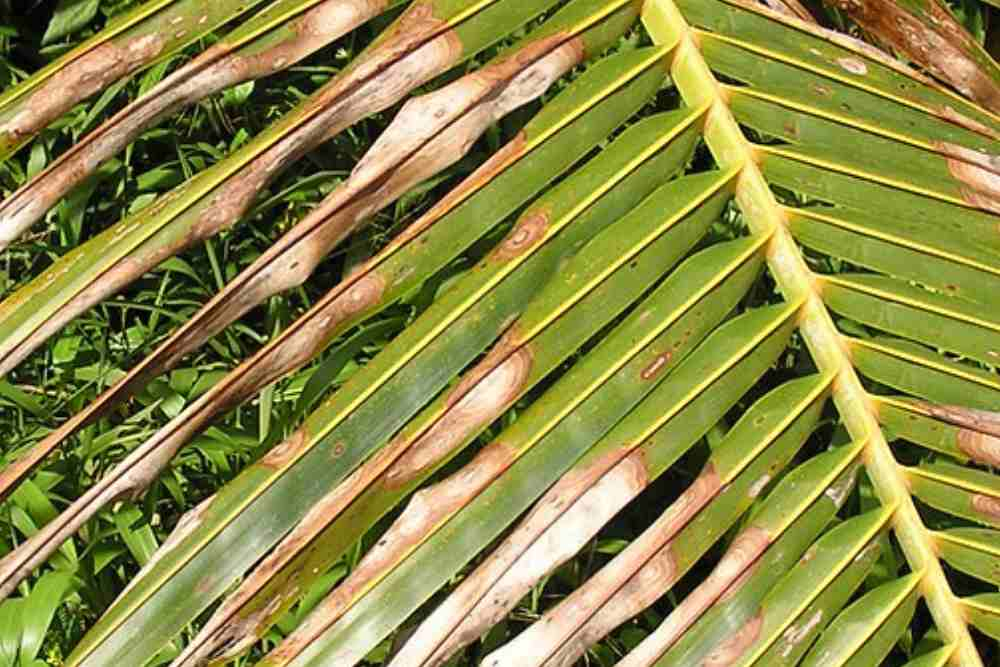
Initially, symptoms appear exclusively on the outer whorl of the leaves, particularly on older leaves. Tiny yellow dots with a grayish edge can be seen on the leaves. Gradually, the center of the spots turns greyish white, with dark brown edges and a yellow halo.
Numerous spots combine to form erratic, grey necrotic areas. The leaf blade completely dries up and shrivels, giving it a blighted or burnt look. A large number of black acervuli, globose or ovoid, develop on the upper surface of the leaves.
Conidia are produced by the fungus inside the acervuli. The acervuli are black, cushion-shaped, and subepidermal, and they split apart to show conidia and black sterile structures called setae. The hyaline, short, straightforward conidiophores bear conidia at the tip singly.
The conidia are five-celled, with the middle three cells being dark in color and the end cells being hyaline with three to five slender, elongated appendages at the tip of the spore.
Soils with poor drainage, soils lacking in potash, 4-5 days of nonstop rain, and severe winds. Infected plant waste in the soil still contains the fungus. In addition, Conidia that are carried by the wind spread the disease.
Management
Remove and burn the infected, fallen leaves periodically. Apply heavy doses of potash. Improve the drainage conditions of the soil. Spray the crown with 0.25 percent copper oxychloride or 1 percent Bordeaux mixture before starting the rainy period.
4. Brown Leaf Spot And Grey Leaf Spot
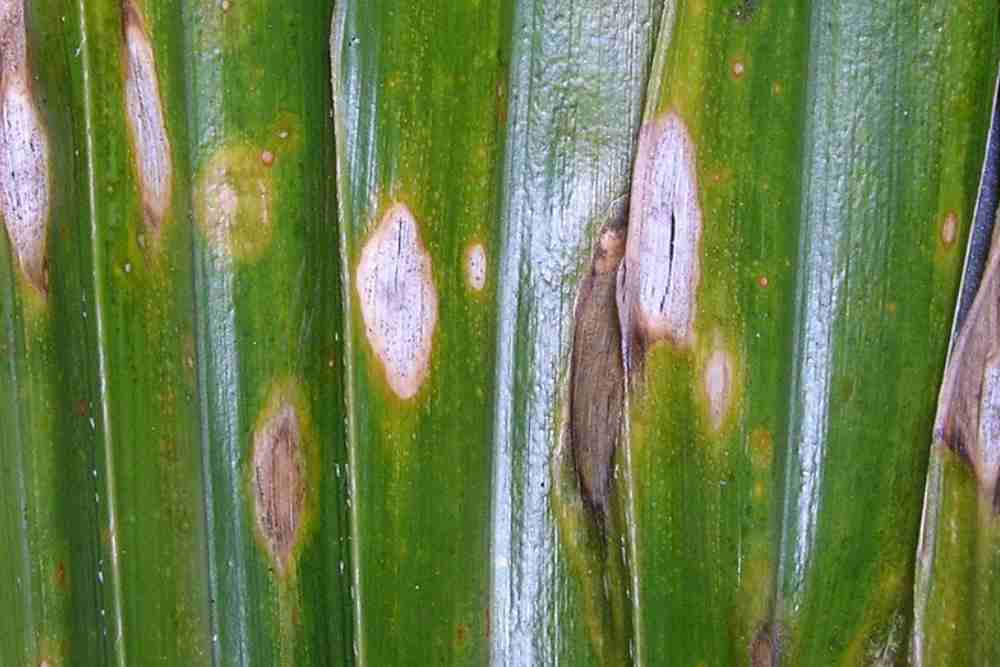
These spots, which may be up to 10 mm long and 4 mm broad and have grey cores and somewhat wide dark brown margins around them, can be found on the top surface of older leaves with brown leaf spot disease. The spot edges are less distinct on the bottom surface, but this is where the black powdery spore masses develop. Only a microscope can clearly see the spores because they are so tiny and rounded.
The gray dots in the grey leaf spot have a narrow dark brown border and can be up to 15 mm long. The spots can occasionally unite and have a yellow halo around them. Particularly on the upper surface of the leaves, tiny black dots within the spots are apparent as fungal fruiting structures.
The infections are more prevalent during wet weather because rain and wind distribute the spores of both of these leaf spot fungi. Both of these fungal infections are more severe on older leaves. In brown leaf spots, this disease typically appears on the older leaves and affects all types of coconuts.
Management
It is doubtful that the diseases affecting older leaves will lower harvests. Sometimes they can be very bad if there have been a lot of rainy days or if the soil where the palms are growing is deficient in nutrients. Improving nutrition and growing conditions is necessary if control measures are required. If spots appear in nurseries when shaded, reduce the amount of shadow.
Fungicides are unlikely to have any effect on these illnesses given the limited harm they inflict, the difficulty applying them, the cost, and the fact that their use is not advised.
5. Lethal Yellowing
Coconut plants can have a disease called Lethal Yellowing. A mycoplasma-like organism is thought to reside inside the coconut palm’s food-conducting veins. The organism will destroy the tree. A bug known as a “leaf hopper” is responsible for spreading the disease.
Lethal yellowing can readily be mistaken for other yellowing and defoliating conditions that affect coconut palms, such as fungal bud rot, nutritional inadequacies, insects, nematodes, and lightning damage. But over time, observations allowed for identifying four symptom stages, of which at least one is definitely symptomatic of the condition.
The first sign of lethal yellowing is the premature dropping of the majority or all of the coconuts, regardless of size. Then, the process of “shelling” is what causes most fallen nuts to have a brown or black region right beneath the calyx on the stem end.
New inflorescence tips (flower stalks) begin to turn black, which is the second stage of lethal yellowing. The inflorescence of healthy trees has a golden yellow color, so this can be seen as they emerge from the spathe (the structure that encased the inflorescence), which is highly distinctive.
Nearly all male flowers on such a flower stalk will be dead in addition to the blackened tips, and no fruit will be set on it. The third stage is where the disease gets its name. The fronds start to yellow, usually starting at the bottom with the elder ones and moving toward the crown.
Frequently, only one particular frond will turn yellow initially, giving it the appearance of a “flag” in the process. Next, yellowed fronds may die, become brown, and hang down, although they will usually cling to the tree rather than falling off.
Only after all the leaves, including the freshly developed spear leaf, have died, does the fourth and final stage occur. First, the bud dies, then the tree’s top falls off, exposing the “telephone pole”-shaped trunk. After the onset of the first symptom, infected trees often die 3 to 6 months later.
Management
A coconut palm that has already contracted the disease cannot now be cured. Any palm that exhibits lethal yellowing symptoms must be cut out and disposed of. Commercial transfer of living palms from disease-affected areas to disease-free areas is sometimes restricted to prevent the spread of lethal yellowing in the tropics.
Removing diseased coconuts, oxytetracycline-inoculating the surrounding palms, and reinstalling resistant palm cultivars are some methods used to manage this disease.
Oxytetracycline HCl (Terramycin), an antibiotic supplied to palms as a liquid injection into the trunk, controls lethal yellowing chemically. Systemic therapy on a 4-month treatment schedule has to start as soon as possible following the beginning of symptoms. Since they are unlikely to react to Terramycin treatment, palms with more than 25% of their leaves wilted should be removed.
When lethal yellowing is known to occur nearby, the antibiotic can also be applied as a preventative measure to safeguard palm trees. The appropriate dosage is determined by the size of the palm being treated. Insecticide use in landscapes or palm plantations shouldn’t be repeated until leafhopper populations are sufficiently controlled.
Read – Coconut Black Headed Caterpillar Life Cycle
- 15 Ingenious Kitchen Garden Ideas to Cultivate Freshness Right at Home - April 7, 2024
- 10 Top Picks Best Plants for Open Terrarium - April 2, 2024
- 21 Easy and Cheap Walkway Ideas for a Charming Garden - March 31, 2024

